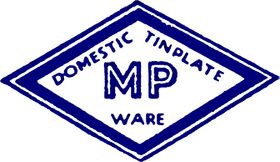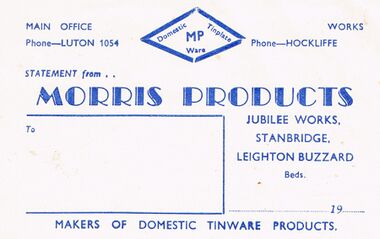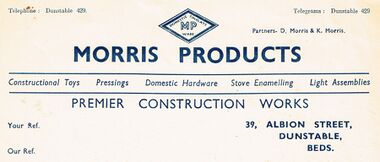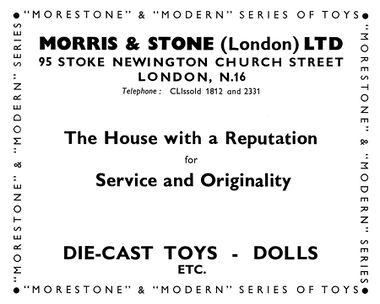Category:Morestone
| Toy Brands and Manufacturers |
|---|
Morestone |
| 1946 - |
Morris Products, Jubilee Works [image info]
1950s: "Morris Products" letterhead [image info]
1956: Morestone advert in Games and Toys [image info]
Morris & Stone was founded in around 1946 by Sam Morris, who set up in Stoke Newington, London and started selling toys, drawing on North London's ecosystem of little metal fabrication and diecasting workshops, which were now able to get hold of metal and allowed to manufacture toys (and looking for business opportunities) now that the war was over and life was starting to revert to normal.
North London
The North London ecosystem was partly due to William Britain's presence in the area since the Nineteenth Century, which meant that here were significant numbers of employees and ex-employees who knew something about metalworking and toys, and that this was a viable way to make money. Initially focused more on lead toy manufacturing, the owners of little local businesses learned new technologies during WW2, and the same ecosystem spawned Die Cast Machine Tools (DCMT, Lone Star Toys) in 1939, and Lesney Products (Matchbox Toys) in around 1947, as well as a slew of minor manufacturing and fabrication businesses whose output would tend to flow into the output of larger companies with more established branding and distribution, as subcontractors.
While the classic example of this ecosystem on practice was Horton supplying their 00-scale range to Britains as the Britains Liliput range, many small workshops's work was never properly documented,with the result that, with some of Morestone/Budgie products, we don't actually know who actually manufactured the original castings, or where the tools originated.
1954: In-house manufacturing
Sam Morris originally concentrated on selling the metal toys made by Modern Products (also founded 1946), supplemented with bits and pieces from other local companies, but 1946 gave Morestone the opportunity to finally have their own manufacturing base.
Rodney Smith had originally been a founder of Lesney, along with Leslie Smith (Les-Ney), but after the ambitious Jack O'Dell joined lesney, Rodney seems to have decided that his input wasn't needed as much, and withdrew to start his own diecasting business. This ran into financial trouble in 1954, at which point Sam Morris bought a half share in the business, creating R. Smith (Diecasting) Ltd.
With the success of Lesney's Matchbox range in 1953 showing what could be achieved with proper unified branding, logos and packaging, Morestone began to experiment with unified product ranges.
1956: ESSO Series
The ESSO Series gathered together a range of about twenty disparate models, six made by Modern Products and another ~fourteen made by other "random" suppliers, as a unified product range. Learning from Lesney's gimmick "Matchbox" packaging, where each toy was supplied in a cardboard box that looked like a matchbox, the "ESSO Series" came packaged in cardboard boxes that looked like ESSO petrol pumps. Launching with a range of ten models, the ESSO series created an identity in the minds of toyshops, stood out visually on shelves, and encouraged buyers to keep collecting more models in the series.
1956: Noddy and His Car
1958: Trucks of the World
The "Trucks of the World International Series" aimed to have the same sort of success with collectors, but was abandoned after three models, presumably eclipsed by Morestone's Big New Idea for a universal range of strongly-branded diecast toy vehicles that could be applied to Morestone's complete output – Budgie Toys!
1959: Budgie Toys
Budgie Toys Launched in 1959. Recognising the psychological importance of giving the impression of having a large and wide range (as shown by Dinky Toys), Morestone initially inflated the apaprent size of the range by starting in the 200's and skipping odd numbers!
Budgie became the default (re/)branding for pretty much everything that Morestone continued to sell.
1961: Guiterman takeover
Recognising that Budgie were now a decent brand, but could do better with proper distribution and marketing, the long-established toy distributor S. Guierman & Co. Ltd bought out Morestone in 1961, and also acquired R.Smith Diecasting. Since the business was now entirely concerned with Budgie, and Morris and the Morris brothers had now left, Guiterman sensibly rebranded their recently acquired company as Budgie Models Ltd. in 1962, and from this point on, references to "Budgie Toys" started to change to "Budgie Models".
Although Budgie Toys was a perfectly fine name for a brand in the UK (Dinky Toys didn't seem to suffer from being referred to as "Toys"), Guiterman may have been thinking ahead in terms of possible exporting to the US, where "Toys" tnded to imply playthings for small children, and the word "Models" was less likely to alienate the teenager who wanted to be considered "grown-up"
1966: Guiterman goes bust
S. Guiterman went into voluntary liquidation in 1966, the result of which also took down Budgie Models and R. Smith.
1966: Modern Products take over
Since Modern Products were still making some of the Budgie range, had physical possession of some of the moulds, knew that there were unresourced orders from the States that they could supply, and had almost no other customers apart from Budgie, Modern Products managed to negotiate taking over the Budgie intellectual rights and orderbook, and focused on producing a small range of budgies for the US market.
Alas, the appearance of Mattell's Hot Wheels low-friction cars in 1968 totally disrupted the diecast toy car market and fundamentally changed the business model for toy cars. Given the carnage wreaked by Hot Wheels on even established and successful UK brands like Dinky Toys and Corgi Toys in their home market in the UK, the idea of a small company selling Budgie Toys into Mattell's home market and making a profit was obviously not going to work any longer.
After meetings with UK distributor H. Seener, Budgie essentially became a company making a limited range of diecast London double-decker buses and London taxicabs for the tourist market. Although the "tourist memento" business seemed to be easier than the "proper" toy market, the relationship between Budgie and Seener broke down in the mid-Eighties.
1983: Starcourt
By this time, the company had reached the end of its natural life, and it was decided to close down and sell everything, lock, stock and Barrel, to the company next door, "Starcourt Ltd", who wanted the building to expand into. Having gotten the moulds and brandname and remaining stocks effectively "for free" when they bought the building, Starcourt decided to continue manufacturing Budgies, but the business essentially stopped in around 1985 with the end of the relationship with Seener.
Modern Times
Repro/reissue Budgies are available from https://www.budgiemodels.com/ , who manufacture in the UK, and supply models in copies of the original yellow boxes.
Subcategories
This category has the following 7 subcategories, out of 7 total.
B
E
- ESSEM Series (empty)
- ESSO Series (empty)
M
- Mobile Vehicle Series (empty)
- Modern Products (empty)
- Modern Vehicle Series (empty)
T
- Trucks of the World (empty)
Media in category ‘Morestone’
The following 4 files are in this category, out of 4 total.
- Morestone, Morris and Stone (GaT 1956).jpg 1,200 × 961; 252 KB
- Morris Products statement slip, 1950s.jpg 1,200 × 755; 214 KB
- Morris Products, letterhead, 1950s.jpg 1,200 × 512; 183 KB
- Morris Products, logo.jpg 671 × 388; 122 KB










